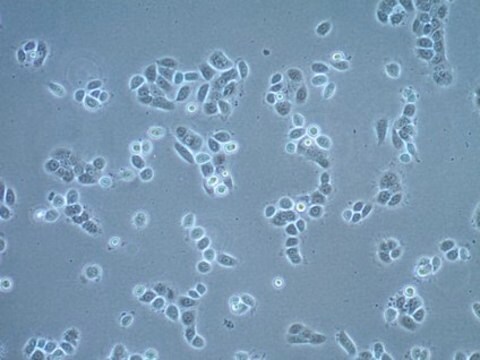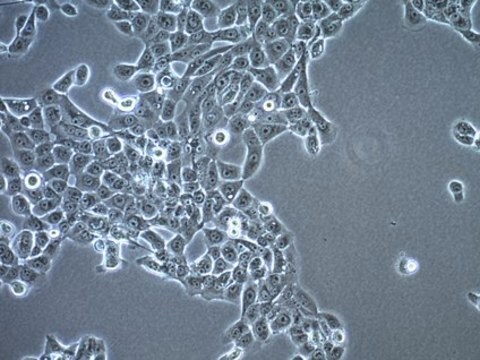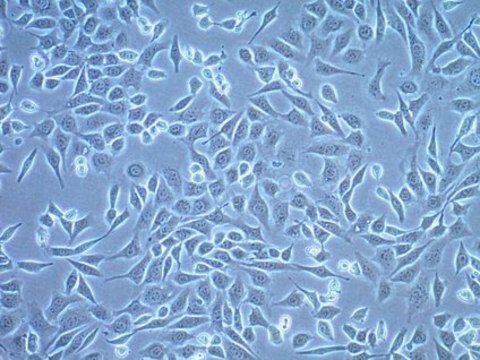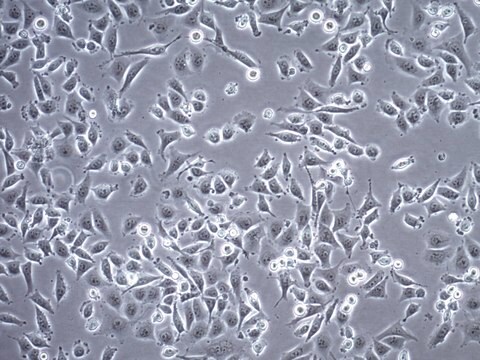SCC148
MB49 Mouse Bladder Carcinoma Cell Line
Mouse
Sinônimo(s):
MB-49
Faça loginpara ver os preços organizacionais e de contrato
About This Item
Código UNSPSC:
41106514
eCl@ss:
32011203
NACRES:
NA.81
Produtos recomendados
product name
MB49 Mouse Bladder Carcinoma Cell Line, MB49 mouse urothelial carcinoma cell line is widely used as an in vitro and in vivo model of bladder cancer.
fonte biológica
mouse
Nível de qualidade
técnica(s)
cell culture | mammalian: suitable
Condições de expedição
ambient
Categorias relacionadas
Descrição geral
MB49 cells are derived from C57BL/Icrf-a’ mouse bladder epithelial cells that were transformed by a single 24-hour treatment with the chemical carcinogen 7, 12-dimethylbenz[a]anthracene (DMBA) on the second day of a long term primary culture . Transformed cells transplanted into syngeneic mice were shown to generate carcinomas . While of male origin, karyotype analyses indicate the loss of the Y chromosome in 100% of the cells analyzed . This abnormality is a frequent early event in human bladder cancer. A recent study indicates that MB49 cells recapitulate key features of sex differences in bladder tumor growth . MB49 implantation in mice resulted in significantly larger tumors in males than females. In the presence of dihydrotestosterone, MB49 cells exhibited enhanced proliferation in a dose-dependent manner. In contrast, MB49 cells were unresponsive to the pregnancy hormone, human chorionic gonadotrophin (hCG) . MB49 cells exhibit low to no expression of MHC-Class I and II molecules . However, upon exposure to IFN-, the expressions of MHC Class I and II are significantly upregulated .
Qualidade
• Each vial contains ≥ 1X106 viable cells.
• Cells are tested negative for infectious diseases by a Mouse Essential CLEAR panel by Charles River Animal Diagnostic Services.
• Cells are verified to be of mouse origin and negative for inter-species contamination from rat, chinese hamster, Golden Syrian hamster, human and non-human primate (NHP) as assessed by a Contamination CLEAR panel by Charles River Animal Diagnostic Services.
• Cells are negative for mycoplasma contamination
• Cells are tested negative for infectious diseases by a Mouse Essential CLEAR panel by Charles River Animal Diagnostic Services.
• Cells are verified to be of mouse origin and negative for inter-species contamination from rat, chinese hamster, Golden Syrian hamster, human and non-human primate (NHP) as assessed by a Contamination CLEAR panel by Charles River Animal Diagnostic Services.
• Cells are negative for mycoplasma contamination
Outras notas
This product is intended for sale and sold solely to academic institutions for internal academic research use per the terms of the "Academic Use Agreement" as detailed in the product documentation. For information regarding any other use, please contact licensing@emdmillipore.com.
Código de classe de armazenamento
10 - Combustible liquids
Classe de risco de água (WGK)
WGK 2
Ponto de fulgor (°F)
Not applicable
Ponto de fulgor (°C)
Not applicable
Certificados de análise (COA)
Busque Certificados de análise (COA) digitando o Número do Lote do produto. Os números de lote e remessa podem ser encontrados no rótulo de um produto após a palavra “Lot” ou “Batch”.
Já possui este produto?
Encontre a documentação dos produtos que você adquiriu recentemente na biblioteca de documentos.
I C Summerhayes et al.
Journal of the National Cancer Institute, 62(4), 1017-1023 (1979-04-01)
Neoplastic transformation of C57BL/lcrf-a' mouse bladder epithelium was induced in long-term primary cultures by a single 24-hour treatment with 7,12-dimethylbenz[a]anthracene on day 2 of culture. Transformed foci appeared earlier (40--60 days) and at a higher frequency (28%) in cultures from
Shai White-Gilbertson et al.
Bladder (San Francisco, Calif.), 3(1) (2016-03-22)
The MB49 syngeneic, murine model of bladder cancer has been widely used for more than 35 years. In humans, bladder cancer is one third as prevalent in women as in men, with a trend toward lower prevalence in parous compared
Andreja Erman et al.
International journal of molecular sciences, 22(12) (2021-07-03)
Non-muscle-invasive bladder cancer is the most common form of bladder cancer. The main problem in managing bladder tumors is the high recurrence after the transurethral resection of bladder tumors (TURBT). Our study aimed to examine the fate of intravesically applied
Pietro Strobbia et al.
Theranostics, 11(9), 4090-4102 (2021-03-24)
For the majority of cancer patients, surgery is the primary method of treatment. In these cases, accurately removing the entire tumor without harming surrounding tissue is critical; however, due to the lack of intraoperative imaging techniques, surgeons rely on visual
Nossa equipe de cientistas tem experiência em todas as áreas de pesquisa, incluindo Life Sciences, ciência de materiais, síntese química, cromatografia, química analítica e muitas outras.
Entre em contato com a assistência técnica








